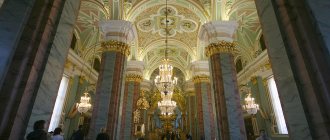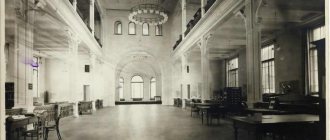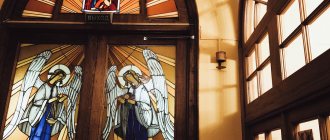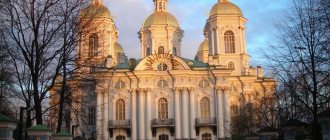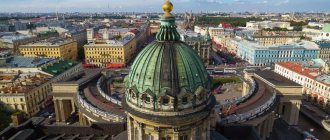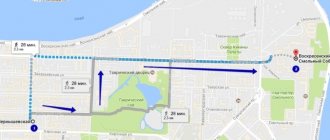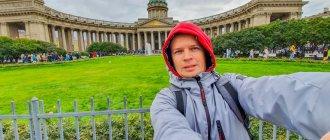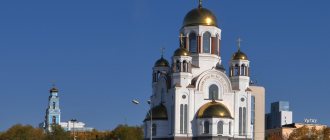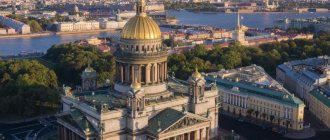| Interior of St. Petersburg Cathedral of St. Spiridon of Trimifuntsky in the Admiralty, until 1920 |
St. Petersburg Cathedral in the name of St.
Spyridon of Trimifuntsky in the Admiralty (St. Petersburg Diocese)
- Thrones: St. Spyridon of Trimifuntsky (chief); St. Isaac of Dalmatia; conception rights Anna; the prophet Hosea; St. Nicholas the Wonderworker
- Address: Russia, 190195, St. Petersburg, Admiralteysky proezd, 2.
- On the map: Yandex.Map, Google map
It was located in the building of the St. Petersburg Admiralty, erected according to the design of I.K. Korobov, on the stocks of which ships were built until the mid-19th century.
Until 1808, there was a house church of Sts. in the Admiralty. Zechariah and Elizabeth. The church in the Admiralty, rebuilt in its current form by A.D. Zakharov, appeared again in 1821, in connection with the construction of a new St. Isaac's Cathedral and the need to continue services. In just five months, in the hall on the second floor, in the southwestern corner, it was built according to the design of O. Montferrand “without unnecessary decoration, with exemplary splendor”
a two-chapel church with choirs, the main chapel of which was consecrated on December 12, 1821 by Archimandrite of the Lavra Tovia (Moiseev) in memory of the birthday of Emperor Alexander I, which fell on St. Spyridon of Trimifuntsky. Chapel St. Isaac was consecrated on December 18 of the same year.
The temple could accommodate up to 2000 people. The throne, the iconostasis of the chapel with the royal doors and utensils were transferred from the old St. Isaac's Cathedral. The interior of the temple was decorated with two rows of white Ionic columns and decorated with large religious paintings. The clergyman, whose duties included prayer services during the laying and launching of ships, also moved here from the cathedral.
When the new St. Isaac's Cathedral was built, the church in the Admiralty was not only not closed, but in 1858 it was called the cathedral of the naval department ( "the general parish of all the ranks of the naval department located in St. Petersburg"
,
“the chief priest asked the Metropolitan of St. Petersburg to declare to all the churches of the capital that they would not consider officials of the naval department to be their parishioners”
[1]) and again, after extensive repairs, they consecrated it on October 1, 1859. A year later, the pediment of the cathedral was decorated with a cross on a ball, made according to a drawing by I. K. Rigler, who in 1863 also erected a stone belfry, where the six bells of the old St. Isaac's Cathedral were hung.
Later, three more chapels appeared in the cathedral: in 1874 - in honor of the conception of rights. Anna; in the fall of 1889 - in the choir, in the name of the prophet Hosea, in memory of the salvation of the imperial family in Borki; in 1891 - in the name of St. Nicholas the Wonderworker.
| Shroud and canopy in St. Petersburg Cathedral of St. Spyridon of Trimifuntsky in the Admiralty |
In 1897, the temple was overhauled, and in 1898 it was decorated with an external cross with lights that were lit during the all-night vigil, which was a novelty for that time.
In 1915, using donations collected, a unique silver shroud in the Empire style with relief decorations and a canopy was made.
Before the revolution of 1917, the cathedral had one of the best choirs in the capital, which sang, in particular, on November 17 at the annual memorial service for the sailors who died in the Sinop and Tsushima battles.
On November 13, 1920, the cathedral was closed.
In 1923, the temple icons were dumped in utility rooms, and two years later they were partially transported to the Museum of an Obsolete Cult.
Nowadays the cathedral premises are occupied by the assembly hall of the Naval Engineering Institute.
In the 1990s, the authorities of the institute several times allowed prayers and memorial services to be held there.
On June 14, 2000, the first public prayer service was held within the walls of the cathedral - St. Spyridon and St. right John of Kronstadt. Temple image of St. Spyridon (from the iconostasis) is preserved by pious Christians in St. Petersburg, who are ready to hand it over if the temple is revived.
On December 25, 2013, the Liturgy was celebrated for the first time in the last 90 years. It was headed by the rector of the church, dean of the Military Deanery District of the St. Petersburg Diocese, Hieromonk Alexy (Ganzhin). The Commander-in-Chief of the Russian Navy, Viktor Chirkov, on whose initiative a petition was written to Metropolitan Vladimir of St. Petersburg and Ladoga to open the temple, handed over the keys to the reconstructed Admiralty Cathedral to Hieromonk Alexy (Ganzhin) [2].
Shrines
- velvet shoe embroidered with gold St. Spyridon of Trimifuntsky. It was brought to the cathedral in 1860 by the chief chaplain of the Army and Navy.
- a pillow that was under St.'s head for some time. Spiridon
- part of the robe of St. Spiridon
- icon of St. Constantine and Helena with six holidays, written on a board, in a narrow silver frame. In the middle of the image there was a box with a silver lid, in which a wooden cross was kept with particles of the Robe of the Lord and the Life-Giving Tree of the Cross of the Lord and with particles of the relics of St. ap. Andrew the First-Called, prophet. Daniel, St. ap. and Evang. Brand, ev. Luke, ap. Bartholomew, St. right Simeon the God-Receiver, St. John the Merciful, St. Spyridon of Trimifuntsky, St. Savva the Sanctified, St. Mikhail Maleina, sschmch. Clement of Ankyra, St. Ephraim of Novotorzh, St. Paphnutius Borovsky, St. John of Damascus, arch. Stephen, St. John Chrysostom, St. Barsanuphius of Kazan, St. Epiphany of Cyprus, Mercury, martyr. Theodore Stratilates, infant of Herod, beaten, great martyr. Panteleimon the Healer, martyr. James of Persia, St. equal to Constantine the Great, Prince Vladimir, St. Blagov. Alexander Nevsky, Prince Theodore, Prince David, Prince Constantine, Blessed. Maxima, ribless Cosmas and Damian, martyr. Barbarians, martyr. Paraskeva, Feodosia maidens.
Saint Spyridon of Trimifuntsky
Memorial Day December 12/25
Saint Spyridon of Trimythous was born at the end of the 3rd century on the island of Cyprus. Little information has been preserved about his life. It is known that he was a shepherd and had a wife and children. He gave all his funds to the needs of his neighbors and strangers, for this the Lord rewarded him with the gift of miracles: he healed the terminally ill and cast out demons. After the death of his wife, during the reign of Emperor Constantine the Great (306-337), he was elected bishop of the city of Trimifunt. In the rank of bishop, the saint did not change his way of life, combining pastoral service with works of mercy. According to church historians, Saint Spyridon in 325 took part in the actions of the First Ecumenical Council. At the Council, the saint entered into a competition with a Greek philosopher who defended the Aryan heresy. The simple speech of Saint Spyridon showed everyone’s weakness. human wisdom before the Wisdom of God: “Listen, philosopher, to what I will tell you: we believe that Almighty God out of nothing created heaven, earth, man and the entire visible and invisible world with His Word and Spirit. This Word is the Son of God, Who came down to earth for our sins, was born of the Virgin, lived with people, suffered, died for our salvation and then rose again, atoning for original sin with His suffering, and resurrected the human race with Himself. We believe that He is Consubstantial and Equal in Honor with the Father, and we believe this without any crafty inventions, for it is impossible to comprehend this mystery with the human mind.”
As a result of the conversation, the opponent of Christianity became its zealous defender and accepted holy Baptism. After a conversation with Saint Spyridon, turning to his friends, the philosopher said: “Listen! While the competition with me was carried out through evidence, I presented others against some evidence and, with my art of argument, reflected everything that was presented to me. But when, instead of proof from reason, some special power began to emanate from the mouth of this old man, evidence became powerless against it, since a person cannot resist God. If any of you can think the same way as I do, then let him believe in Christ and, together with me, follow this old man, through whose mouth God Himself spoke.”
At the same Council, Saint Spyridon presented against the Arians a clear proof of the Unity in the Holy Trinity. He took a brick in his hands and squeezed it: fire instantly came out of it, water flowed down, and the clay remained in the hands of the miracle worker. “Behold, there are three elements, and there is one plinth (brick),” said St. Spyridon then, “so in the Most Holy Trinity there are Three Persons, but the Divinity is One.”
The saint took care of his flock with great love. Through his prayer, the drought was replaced by abundant life-giving rain, and continuous rains were replaced by bucketfuls. the sick were healed, demons were cast out.
One day a woman came to him with a dead child in her arms, asking for the saint’s intercession. After praying, he brought the baby back to life. The mother, shocked by joy, fell lifeless. But the prayer of the saint of God restored life to the mother.
Once, rushing to save his friend, slandered and sentenced to death, the saint was stopped on his way by a stream that unexpectedly overflowed from a flood. The saint ordered the stream: “Stand up!” This is what the Lord of the whole world commands you, so that I can cross and the husband for whose sake I am hastening may be saved.” The will of the saint was fulfilled. and he safely crossed to the other side. The judge, warned about the miracle that had occurred, met Saint Spyridon with honor and released his friend.
Such a case is also known from the life of the saint. One day he entered an empty church, ordered the lamps and candles to be lit, and began the Divine Service. Having proclaimed “Peace to all,” he and the deacon heard in response from above a great multitude of voices shouting: “And to your spirit.” This choir was great and sweeter than any human singing. At each litany, an invisible choir sang “Lord, have mercy.” Attracted by the singing coming from the church, people nearby hurried to her. As they approached the church, wonderful singing filled their ears more and more and delighted their hearts. But when they entered the church, they saw no one except the bishop with a few church servants, and they no longer heard heavenly singing. from which they came to great amazement.
Saint Simeon Metaphrastus, a description of his life. likened Saint Spyridon to Patriarch Abraham in the virtue of hospitality. “You also need to know how he received strangers,” wrote Sozomen, who was close to monastic circles, citing in his “Church History” an amazing example from the life of the saint. One day, after the approach of Lent, a wanderer knocked on his house. Seeing that the traveler was very tired, Saint Spyridon said to his daughter: “Wash this man’s feet and offer him something to eat.” But due to fasting, the necessary supplies were not made, for the saint “ate food only on a certain day, and on others he remained without food.” Therefore, the daughter replied that there was no bread or flour in the house. Then Saint Spyridon, apologizing to the guest, ordered his daughter to fry the salted pork meat that was in stock and. Having seated the wanderer at the table, he began to eat, “convincing that man to imitate himself. When the latter, calling himself a Christian, refused, he added: “It is all the less necessary to refuse, for the Word of God has spoken: All things are pure (Titus 1:15).”
Another story, reported by Sozomen, is also very characteristic of the saint: the saint had the custom of distributing one part of the harvest to the poor, and giving the other part to the needy as a loan. He himself did not personally give anything, but simply showed the entrance to the storeroom, where everyone could take as much as they needed and then return it in the same way, without checking or reporting.
There is also a well-known story by Socrates Scholasticus about how thieves decided to steal the sheep of Saint Spyridon: in the dead of night they climbed into a sheepfold, but immediately found themselves tied up by an invisible force. When morning came, the saint came to the herd and, seeing the bound robbers, prayed, untied them and for a long time persuaded them to leave their lawless path and earn food by honest labor. Then, giving them a sheep each and sending them away, he said kindly: “Let it not be in vain that you kept watch.”
Saint Spyridon is often compared to the prophet Elijah, for also through his prayer, during droughts that often threatened the island of Cyprus, it rained: “We see Spyridon, the great wonderworker, equal to the angel. Once upon a time the country suffered greatly from lack of rain and drought: there was a famine and a plague, and many people died, but through the prayers of the saint, rain came down from heaven to earth: the people, having been delivered from the disaster, cried out in gratitude: Rejoice, thou who art like the great prophet, and the rain that takes away the famine and sicknesses, Thou hast sent down in good time.”
The entire life of the saint amazes with its amazing simplicity and power of miracles. given to him by the Lord. According to the word of the saint, the dead awakened, the elements were tamed, and idols were crushed. When the Patriarch convened a Council in Alexandria for the sake of crushing idols and temples, through the prayers of the fathers of the Council, all the idols fell, except one, the most revered. It was revealed to the Patriarch in a vision that this idol remained in order to be crushed by Saint Spyridon of Trimythous. Summoned by the Council, the saint boarded the ship, and at the moment when the ship landed on the shore and the saint set foot on land, the idol in Alexandria with all the altars was thrown into dust, which announced to the patriarch and all the bishops the approach of St. Spyridon.
Saint Spyridon lived his earthly life in righteousness and holiness and in prayer gave up his soul to the Lord (c. 348). In the history of the Church, Saint Spyridon is venerated together with Saint Nicholas, Archbishop of Myra.
His relics rest on the island of Corfu in the church named after him (except for the right hand, which is in Rome).
Troparion of St. Spyridon, tone 1
At the First Council, you appeared as a champion and wonderworker,/ God-bearing Spyridon, Our Father./ You also cried out to the dead in the tomb,/ and you turned the serpent into gold,/ and you never sang holy prayers to you,/ You had angels co-serving with you, most sacred. / Glory to Him who gave you strength, / glory to Him who crowned you, / glory to Him who heals you all.
Kontakion of Saint Spyridon, tone 2
Having been wounded by the love of Christ, O most sacred one,/ your mind was fixed on the dawn of the Spirit,/ through your diligent vision you found an act more pleasing to God,/ the Divine altar became, // asking for the Divine radiance to all.
Source: Pravoslavie.Ru
Share link:
- Click to share on Twitter (Opens in new window)
- Click here to share content on Facebook. (Opens in a new window)
Similar
Priests
- A.I. Yakubovich (1859 - August 14, 1875)
- Pyotr Belyavin (1875 - 1885)
- Mikhail Kutnevich (1885)
- Alexander Zlatkovsky (1885)
- Yanovsky Moisey Vasilievich (? - May 7, 1896)
- Ioann Nevdachin (1896 - 1897)
- Vasily Molodensky (1898 - 1904)
- Vladimir Kazmin (1900 - 1912)
- Anatoly Zamaraev (May 10, 1907 - August 17, 1909)
- Dimitry Udimov (1909 - 1911)
- Konstantin Krasovsky (September 1, 1911 - 1918)
- Fyodor Laskeyev (1916)
Palace and park ensemble
The Oranienbaum Museum-Reserve is so vast and rich that it requires special attention. On its land there are many attractions: architectural monuments, statues, a magnificent garden and a huge park.
Menshikov Palace
- Address: Upper Park, 1.
The favorite of Peter I lived in grand style and literally bathed in luxury. The magnificent palace matches its owner: two semicircular galleries with pavilions, like giant hands, trying to capture as much territory as possible. The symmetrical pavilions are adjacent to two long wings - the Japanese and the Church. In the center stands a two-story building, crowned with a huge crown. The palace was built in the favorite style of Peter the Great - Baroque.
Menshikov deliberately built his residence on a hill not far from the shore, so that all ships entering the Gulf of Finland would immediately notice the palace and admire its splendor. In subsequent centuries, the Grand Palace was rebuilt several times under the leadership of Francesco Rastrelli, Antonio Rinaldi and other talented architects. The grandiose structure miraculously survived the Great Patriotic War.
Palace of Peter III
- Address: Upper Park, 2.
The small house in which Catherine the Great’s husband loved to relax bears little resemblance to a palace. The modest two-story building is devoid of external decor, but has a rich interior.
Peter's Palace was the finishing touch to the creation of the Amusement Fortress in the mid-18th century. The famous Peterstadt fortress was built for the amusement of Peter III, whose unhealthy passion for the art of war became the talk of the town. Over the years, only the palace of Peter Fedorovich and the Gate of Honor remained from the Poteshny town.
During the Great Patriotic War, the palace became a repository for museum exhibits. 8 years after the Victory, an exhibition of oriental art opened in the building, which continues to operate to this day.
Chinese Palace
- Address: Verkhniy Park, 7A.
A beautiful palace in the Rococo style was built in the Upper Park during the reign of Catherine II. The name of the palace and its interior decoration are a tribute to the fashion of that time. In the 18th century, civilized Western countries became interested in Eastern art. The exotic and mysterious culture of China attracted many Europeans and Russian aristocrats.
Catherine the Great loved to relax and have fun in the Chinese Palace with her courtiers and favorites.
Each of the 17 halls is unique in its design and purpose. The Hall of the Muses is painted with figures of ancient muses, the Glass Bead Cabinet is decorated with embroidered panels, and the Chinese Cabinets are full of souvenirs from China and Japan. The palace has hardly changed over the past centuries, many of the exhibits are authentic.
Chinese cuisine
- Address: Linden Alley.
There is a small kitchen building next to the Chinese Palace. The cross-shaped pavilion is built in the same style as the palace and is painted pink. The unusual structure appeared during the period of reconstruction of the Chinese Palace under Grand Duchess Elena Pavlovna. Previously, food for the inhabitants of the estate was prepared in the Cavalry Corps. All rooms of the new building were equipped for various economic needs. The kitchen had an icehouse and a wine cellar.
Roller coaster
- Address: English Alley.
In the mid-18th century, the Menshikov estate went to the future Emperor Peter Fedorovich. As a result of the coup d'etat, Peter III was killed, and his wife ascended to the Russian throne. Having become the full-fledged mistress of the estate, Catherine first began building her own palaces.
To entertain the Empress and her retinue, the Rolling Hill complex was built. At a height of 20 meters there was a special platform, from which straight and wavy wooden slopes stretched. The courtiers sat in small carriages, decorated with carvings and gilding, and rode down. Afterwards the stroller was lifted up along the side tracks.
The roller coaster completely collapsed by the beginning of the 19th century. All that remains from the former complex is a magnificent stone pavilion. The blue and white building of an unusual design is one of the main treasures of Oranienbaum. The two-tier pavilion is richly decorated with columns and sculptures, making the building seem airy. The interior is decorated with stucco, gold and paintings, the floor is made of artificial marble.
Lower Garden
- Coordinates on the map: 59.915833, 29.755041.
The garden began to be planted soon after the construction of the estate. For many years, flowers and ornamental shrubs grew around the palace. The planting had geometrically clear, symmetrical shapes in the European style. Currently, professional gardeners are working on the garden. Every spring, the territory is decorated with labyrinths of trimmed bushes, flower beds arranged in intricate patterns. From a bird's eye view, the garden looks like a colorful carpet.
Upper Park
- Address: Soykinskaya Alley.
A huge park stretches for several kilometers around the Grand Palace. On its territory you can see many reservoirs, three dozen ancient bridges and centuries-old trees. Among the green spaces hide sophisticated sculptures, statues of beautiful maidens and muscular youths. The Karasta River divides the park into two unequal parts.
Menagerie
- Address: Upper Park.
In addition to military affairs, Peter III was fond of hunting. Following the tradition of his ancestors, the future emperor founded a menagerie at the residence. Wild forest animals and exotic birds were kept in the hunting park. The descendants of the ruler practically did not use the menagerie for hunting pleasures. In 2001, the old menagerie was reborn as a peaceful zoo, where tourists with children often come.
Schedule of services[edit]
The chapel is open daily:
Monday Wednesday
: from 12:00 to 19:00, at 17:00 - prayer for health with akathist to St. Spiridon.
Tuesday Thursday
from 12:00 to 19:00, at 17:00 - prayer service to St. Spiridon and memorial service.
Friday
from 12:00 to 19:00, at 16:30 - prayer service to St. Spyridon with an akathist to the Mother of God.
Saturday
from 10:00 to 19:00, at 14:00 - prayer service to St. Spiridon and memorial service.
Resurrection
from 15:00 to 18:00, at 16:30 - prayer service to St. Spyridon about starting a good deed with an akathist to the Lord Jesus.
On the eve of great church holidays, the chapel is open from 12:00 to 15:00. A prayer service is served at 14:00.
Museums of the city of Lomonosov
Lomonosov can be called a museum city. The city's museum collections number tens of thousands of rare and unique exhibits.
"Stone Hall"
- Address: English Alley.
A small two-story palace-pavilion in the Baroque style was intended to host balls, masquerades and concerts. In 1844, they unexpectedly decided to convert the landmark into a Protestant church. A bell tower was added to the building, and the interior was completely redone. Several decades later, the pavilion was restored to its original appearance. Currently, the palace hosts an exhibition of sculptures and hosts summer classical music concerts.
Picture house
- Address: Palace Avenue, 50.
The beautiful symmetrical building was built in 1755. The gallery housed paintings collected by Peter III. During the difficult years of the blockade, the only school operated in the house. After the end of the war, an art museum was located inside. At the moment, the collection of this Lomonosov landmark includes several surviving paintings from the original collection.
Museum of the Polar Expedition named after B.V. Malin
- Address: st. Pobeda, 24.
A small museum dedicated to the Polar Geophysical Expedition. Museum exhibitions tell about the exploration of the World Ocean and the conquest of the Arctic and Antarctic. Visitors are clearly shown the harsh conditions under which courageous scientists worked and the sacrifices they had to make for the sake of their discoveries. A separate exhibition is dedicated to the memory of deceased expedition participants.
